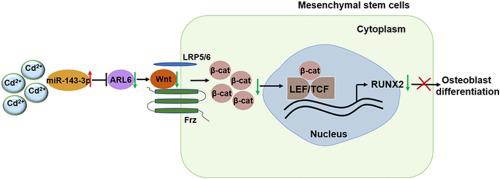当前位置:
X-MOL 学术
›
Toxicol. Lett.
›
论文详情
Our official English website, www.x-mol.net, welcomes your
feedback! (Note: you will need to create a separate account there.)
MircoRNA-143-3p regulating ARL6 is involved in the cadmium-induced inhibition of osteogenic differentiation in human bone marrow mesenchymal stem cells
Toxicology Letters ( IF 2.9 ) Pub Date : 2020-10-01 , DOI: 10.1016/j.toxlet.2020.06.001 Lu Wu 1 , Jia Song 2 , Junchao Xue 1 , Tian Xiao 1 , Qinzhi Wei 2 , Ziji Zhang 3 , Yangcong Zhang 2 , Ziyin Li 2 , Youkun Hu 4 , Gaoqiang Zhang 4 , Haibo Xia 1 , Junjie Li 1 , Xingfen Yang 2 , Qizhan Liu 1
Toxicology Letters ( IF 2.9 ) Pub Date : 2020-10-01 , DOI: 10.1016/j.toxlet.2020.06.001 Lu Wu 1 , Jia Song 2 , Junchao Xue 1 , Tian Xiao 1 , Qinzhi Wei 2 , Ziji Zhang 3 , Yangcong Zhang 2 , Ziyin Li 2 , Youkun Hu 4 , Gaoqiang Zhang 4 , Haibo Xia 1 , Junjie Li 1 , Xingfen Yang 2 , Qizhan Liu 1
Affiliation

|
Cadmium, which is extensively distributed in the environment, accumulates in organisms through the trophic chain. Although cadmium can cause bone injury, its role in osteogenesis of human bone marrow mesenchymal stem cells (hBMSCs) remains unclear. The present study investigated the effect of cadmium chloride (CdCl2) on osteogenesis of hBMSCs and the underlying mechanism. CdCl2 dose-dependently reduced the viability of hBMSCs. Concentrations of CdCl2 (2.5 and 5.0 μM) increased miR-143-3p levels; decreased levels of adenosine diphosphate-ribosylation factor-like protein 6 (ARL6); inhibited Wnt family member 3A (Wnt3a), β-catenin, lymphoid enhancer factor (LEF1), and T-cell factor 1 (TCF1); and suppressed osteogenesis of hBMSCs. Inhibition of miR-143-3p or overexpression of ARL6 with lentivirus blocked these CdCl2-induced changes. Luciferase reporter assays confirmed that miR-143-3p binds to the 3'-UTR regions of ARL6 mRNA. Reduced-expression of miR-143-3p enhanced the CdCl2-induced suppression of the osteogenesis of hBMSCs and inhibition of the Wnt/β-catenin pathway, effects that were reversed by down-regulated expression of ARL6. Thus, miR-143-3p targets ARL6 to down-regulate the Wnt/β-catenin pathway, which is involved in the suppression of osteogenic differentiation of hBMSCs. The results provide new directions for clinical treatment of bone diseases resulting from cadmium toxicity.
中文翻译:

MircoRNA-143-3p 调控 ARL6 参与镉诱导的人骨髓间充质干细胞成骨分化抑制
镉在环境中广泛分布,通过营养链在生物体内积累。尽管镉可引起骨损伤,但其在人骨髓间充质干细胞 (hBMSCs) 成骨中的作用仍不清楚。本研究调查了氯化镉 (CdCl2) 对 hBMSCs 成骨的影响及其潜在机制。CdCl2 剂量依赖性地降低 hBMSCs 的活力。CdCl2 的浓度(2.5 和 5.0 μM)增加了 miR-143-3p 水平;二磷酸腺苷-核糖基化因子样蛋白 6 (ARL6) 水平降低;抑制 Wnt 家族成员 3A (Wnt3a)、β-连环蛋白、淋巴增强因子 (LEF1) 和 T 细胞因子 1 (TCF1);并抑制 hBMSCs 的成骨。用慢病毒抑制 miR-143-3p 或过表达 ARL6 可阻止这些 CdCl2 诱导的变化。荧光素酶报告基因检测证实 miR-143-3p 与 ARL6 mRNA 的 3'-UTR 区域结合。miR-143-3p 的降低表达增强了 CdCl2 诱导的 hBMSCs 成骨抑制和 Wnt/β-catenin 通路的抑制,这些作用被 ARL6 的下调表达逆转。因此,miR-143-3p 靶向 ARL6 以下调 Wnt/β-catenin 通路,该通路参与抑制 hBMSCs 的成骨分化。研究结果为镉毒性引起的骨病的临床治疗提供了新的方向。通过下调 ARL6 表达逆转的影响。因此,miR-143-3p 靶向 ARL6 以下调 Wnt/β-catenin 通路,该通路参与抑制 hBMSCs 的成骨分化。研究结果为镉毒性引起的骨病的临床治疗提供了新的方向。通过下调 ARL6 表达逆转的影响。因此,miR-143-3p 靶向 ARL6 以下调 Wnt/β-catenin 通路,该通路参与抑制 hBMSCs 的成骨分化。研究结果为镉毒性引起的骨病的临床治疗提供了新的方向。
更新日期:2020-10-01
中文翻译:

MircoRNA-143-3p 调控 ARL6 参与镉诱导的人骨髓间充质干细胞成骨分化抑制
镉在环境中广泛分布,通过营养链在生物体内积累。尽管镉可引起骨损伤,但其在人骨髓间充质干细胞 (hBMSCs) 成骨中的作用仍不清楚。本研究调查了氯化镉 (CdCl2) 对 hBMSCs 成骨的影响及其潜在机制。CdCl2 剂量依赖性地降低 hBMSCs 的活力。CdCl2 的浓度(2.5 和 5.0 μM)增加了 miR-143-3p 水平;二磷酸腺苷-核糖基化因子样蛋白 6 (ARL6) 水平降低;抑制 Wnt 家族成员 3A (Wnt3a)、β-连环蛋白、淋巴增强因子 (LEF1) 和 T 细胞因子 1 (TCF1);并抑制 hBMSCs 的成骨。用慢病毒抑制 miR-143-3p 或过表达 ARL6 可阻止这些 CdCl2 诱导的变化。荧光素酶报告基因检测证实 miR-143-3p 与 ARL6 mRNA 的 3'-UTR 区域结合。miR-143-3p 的降低表达增强了 CdCl2 诱导的 hBMSCs 成骨抑制和 Wnt/β-catenin 通路的抑制,这些作用被 ARL6 的下调表达逆转。因此,miR-143-3p 靶向 ARL6 以下调 Wnt/β-catenin 通路,该通路参与抑制 hBMSCs 的成骨分化。研究结果为镉毒性引起的骨病的临床治疗提供了新的方向。通过下调 ARL6 表达逆转的影响。因此,miR-143-3p 靶向 ARL6 以下调 Wnt/β-catenin 通路,该通路参与抑制 hBMSCs 的成骨分化。研究结果为镉毒性引起的骨病的临床治疗提供了新的方向。通过下调 ARL6 表达逆转的影响。因此,miR-143-3p 靶向 ARL6 以下调 Wnt/β-catenin 通路,该通路参与抑制 hBMSCs 的成骨分化。研究结果为镉毒性引起的骨病的临床治疗提供了新的方向。











































 京公网安备 11010802027423号
京公网安备 11010802027423号